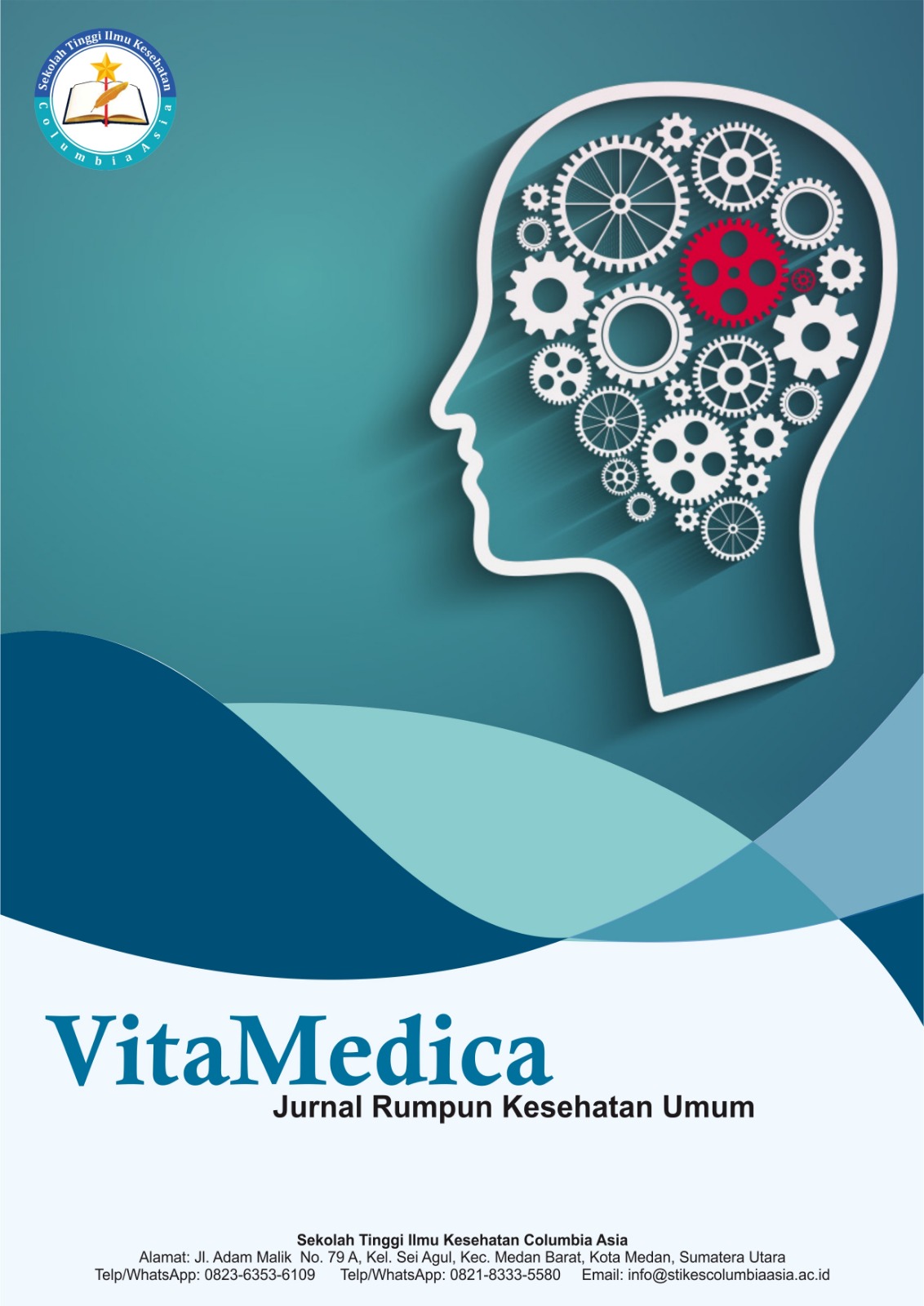Hubungan Pengetahuan Dengan Sikap Ibu Hamil Tentang Manfaat Rebusan Air Jahe Dalam Mengurangi Mual Muntah Pada Ibu Hamil Trimester I
DOI:
https://doi.org/10.62027/vitamedica.v3i2.471Keywords:
knowledge, attitude, pregnant women, ginger, nausea and vomitingAbstract
Nausea and vomiting during the first trimester of pregnancy are common physiological symptoms that may interfere with maternal comfort and nutritional intake. One widely accepted non-pharmacological therapy to reduce these symptoms is ginger decoction, due to its antinausea properties derived from active compounds such as gingerol and shogaol. This study aims to determine the relationship between pregnant women's level of knowledge and their attitudes toward the use of ginger decoction to alleviate nausea and vomiting in the first trimester. This research employed a quantitative method with a descriptive-analytic design. The population included all first-trimester pregnant women visiting Pratama Madina Clinic during January–February 2024, totaling 47 respondents selected using total sampling. Data collection used a structured questionnaire, and the data were analyzed using univariate and bivariate techniques, with the Chi-square test applied. The results showed that 75% of respondents had good knowledge and demonstrated a positive attitude toward using ginger decoction. The Chi-square analysis revealed a significant relationship between knowledge and attitude (p = 0.000). The study concludes that knowledge level influences pregnant women's attitudes toward herbal therapy, and ginger decoction is well-accepted as a non-pharmacological option to reduce pregnancy-related nausea and vomiting. Further health education is recommended to enhance awareness of safe and effective natural therapies for pregnant women.
References
Ahmad, N. (2019). The effectiveness of ginger extract on reducing nausea and vomiting in pregnancy: A review. Indonesian Journal of Midwifery Research, 3(1), 45–52. https://doi.org/10.20473/ijmr.v3i1.2019.
Ali, B. H., Blunden, G., Tanira, M. O., & Nemmar, A. (2020). Some phytochemical, pharmacological and toxicological properties of ginger (Zingiber officinale Roscoe): A review of recent research. Food and Chemical Toxicology, 147, 111809. https://doi.org/10.1016/j.fct.2020.111809.
Aulia, D. (2021). Efektivitas sari jahe terhadap emesis gravidarum pada ibu hamil trimester I. Jurnal Kesehatan Reproduksi Indonesia, 7(2), 101–109. https://doi.org/10.20473/jkri.v7i2.2021.
Azwar, S. (2019). Sikap manusia: Teori dan pengukurannya (ed. revisi). Yogyakarta: Pustaka Pelajar.
Chortatos, A., Haugen, M., Iversen, P. O., Vikanes, Å., Eberhard-Gran, M., & Bjelland, E. K. (2020). Pregnancy complications and birth outcomes associated with nausea and vomiting in pregnancy: A population-based study. BMC Pregnancy and Childbirth, 20, 5–12. https://doi.org/10.1186/s12884-020-02820-z.
Depkes RI. (2020). Profil Kesehatan Indonesia Tahun 2020. Jakarta: Kementerian Kesehatan Republik Indonesia.
Gunawan, M. (2020). Morning sickness dan pencegahannya melalui terapi herbal. Jurnal Ilmiah Kebidanan, 5(1), 33–39. https://doi.org/10.33086/jik.v5i1.2020.
Hasanah, R. (2021). Kandungan minyak atsiri dalam jahe dan efeknya terhadap sistem pencernaan. Jurnal Fitofarmaka Indonesia, 8(1), 22–29. https://doi.org/10.25077/jfi.8.1.2021.22-29.
Henukh, Y., & Aning, D. (2019). Terapi non farmakologis dalam penanganan keluhan kehamilan. Jurnal Keperawatan Maternitas, 6(2), 90–97. https://doi.org/10.34310/jkm.v6i2.2019.
Hidayat, A. A. (2021). Metode penelitian kebidanan dan analisis data. Jakarta: Salemba Medika.
Inthan, A. (2020). Faktor risiko terjadinya hiperemesis gravidarum. Jurnal Ilmiah Kebidanan, 9(2), 64–71. https://doi.org/10.33560/jik.v9i2.2020.
Maulana, H. (2019). Kesehatan reproduksi wanita: Pendekatan holistik. Jakarta: Rineka Cipta.
Nisa, F. (2020). Konsumsi jahe sebagai terapi aman ibu hamil. Jurnal Herbal Indonesia, 5(2), 88–94. https://doi.org/10.31294/jhi.v5i2.2020.
Notoatmodjo, S. (2020). Metodologi penelitian kesehatan. Jakarta: Rineka Cipta.
Rukmana, R. (2020). Jahe: Budidaya dan manfaat kesehatan. Bandung: Kanisius.
Santoso, S. (2019). Pemanfaatan tanaman jahe dalam pengobatan tradisional. Prosiding Seminar Nasional Tanaman Obat, 10(1), 113–121.
Setyowati, H. (2019). Emesis gravidarum dan dampaknya terhadap kehamilan. Jurnal Kebidanan dan Kesehatan, 11(3), 56–62. https://doi.org/10.25077/jkk.11.3.2019.56-62.
Tyastuti, R., & Wahyuningsih, S. (2021). Perubahan fisiologis pada kehamilan trimester pertama dan pencegahannya. Jurnal Kehamilan Sehat, 4(2), 70–78. https://doi.org/10.21009/jks.v4i2.2021.
Vutyavanich, T., Kraisarin, T., & Ruangsri, R. (2022). Ginger for nausea and vomiting in pregnancy: Randomized trial. Obstetrics & Gynecology, 139(1), 577–582. https://doi.org/10.1097/AOG.0000000000004600.
WHO. (2021). Guideline: Nausea and vomiting in pregnancy. Geneva: World Health Organization.
Yuliani, E., & Hartati, A. (2020). Pengaruh rebusan jahe terhadap mual muntah ibu hamil. Jurnal Pengabdian Masyarakat Kesehatan, 5(1), 12–18. https://doi.org/10.31294/jpmk.v5i1.2020.
Downloads
Published
How to Cite
Issue
Section
License
Copyright (c) 2025 VitaMedica : Jurnal Rumpun Kesehatan Umum

This work is licensed under a Creative Commons Attribution-ShareAlike 4.0 International License.







